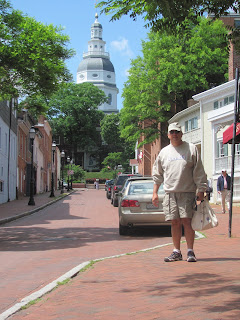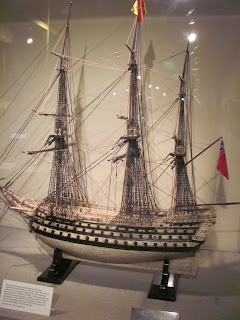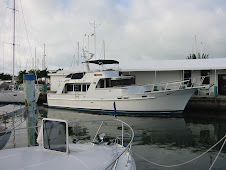Tuesday, May 15, 2012
May 9-11, 2012 - Annapolis, MD
Back in the Chesapeake, traffic picks up. Here is a container ship, loaded with semi trailer containers.
The Thomas Point Shoal Light marks the way to the Severn River and Annapolis. This screwpile style lighthouse is traditional to the Chesapeake.
Near Annapolis, we selected a protected and quiet anchorage in Lake Ogleton, close enough to get an early berth at the City Dock the next day.
As we approached the city, the skyline came into view. The large dome is the Chapel at the Naval Academy, the most noted landmark from the Severn River.
The smaller dome, the Capitol dome of the legislative assembly of the State of Maryland, is also visible from the harbor.
The Annapolis City Docks are down an impossibly narrow fairway called “Ego Alley” – more about that later. We docked here for two nights.
The town’s Main Street was bustling with cars and tourists. At the end of the street is Church Circle, centered by the historic St. Anne’s Episcopal Church.
Our walkabout took us by the Capitol.
While the Annapolis Yacht Club didn’t have any available slips that could accommodate Monarch (!), they could accommodate us for dinner, so we did. The club started on a pile of oyster shells in 1883 as a canoe club. The 1963 clubhouse replaced a more historic building, whose floor listed so badly that people dancing at parties all drifted to the low side.
Back at Monarch, the Capitol was attractively lit just below Venus. Beautiful and peaceful…. but not for long!
Next day, a Friday, was even busier. We started with a tour of the Naval Academy grounds, also known as the Yard.
The entrance to the academy was so close to our dock, you can see Monarch in the background.
Martha admires a torpedo at the monument commemorating the 52 American submarines and crew totaling 3,621 who were lost in World War II. An additional two submarines and 228 crew have been lost during the following peacetime years. “Sailor, rest your oar.”
A French-flagged tall ship has received permission from the Superintendent to temporarily dock at the Academy.
The midshipmen learn sailing the old-fashioned way – on these sailboats docked in the Academy’s Santee Basin.
Jerry admires the dent in this War of 1812 (200 years ago!) British cannon, which was hit by an American shot, then recoiled and killed a British commander.
This is Bancroft Hall, the largest dormitory in the U.S. It contains about 1,700 midshipman rooms, nearly five miles of corridors and about 33 acres of floor space. Jerry’s brother Mark lived here during the time he attended the Academy.
Outside Bancroft Hall is Tecumseh Court, where Indian warrior Tecumseh stands watch over the midshipmen. We only saw a few of the students, as the semester was over, and Commencement was scheduled for the last week of May.
The Academy Chapel is located on a high point of the Yard, with a sweeping view of the Severn River.
The main floor interior of this interdenominational Chapel was open, though we were not able to visit the lower level, where one of the greatest Revolutionary War naval heroes, John Paul Jones, is enshrined.
Tiffany and Gorham Studios designed beautiful stained glass windows that grace the church.
In Preble Hall, we toured the U.S. Naval Academy Museum’s collections of historic treasures, paintings and artifacts. We especially enjoyed the Rogers Collection of antique ship models.
The 1797 Constitution, replicated in this 48:1 scale model, had construction of live oak almost impervious to enemy fire. She was nicknamed “Old Ironsides.”
This is a huge model of Admiral Horatio Nelson’s flagship Victory. This and many other models in the collection were actually made by French prisoners of war, during the Wars of the French Revolution and Empire. Incarcerated in England, they whiled away the time by building these models out of the simplest of materials – wood, straw, and bones from their meager beef rations, held together by animal hide glue and tiny tacks. This model alone was said to have taken 15 French prisoners-of-war two years to build.
Officers’ housing, with nautical striped awnings, comes in individual homes and duplexes.
Here are two old goats. The bronze one on the left has been the official mascot of the Naval Academy since the first Army-Navy football game in 1890.
Back on the waterfront, the small fairway of the Annapolis City Docks is known as Ego Alley. Skippers show off their boats and nautical skills, as they maneuver in the small basin, which is always crowded with tourists and onlookers.
Even the tourist boats, like the Sea Gypsy, do the ego strut!
We saw a near miss with this center console almost running down the small sailboat.
The beautiful small daysailer is a Hirschoff.
While the adjacent boat set up and partied (until 2:30 am!), we opted for a quiet dinner ashore at the c. 1747 Reynolds Tavern on Church Circle, across from St. Anne’s Episcopal Church. The Tavern welcomes guests for meals and lodging. We dined on andouille sausage, shrimp and scallop vols au vent at the sidewalk café, watching passersby as the night came on.
Subscribe to:
Post Comments (Atom)
































1 comment:
As a long time sailor of the Chesapeake, it is wonderful to read your account of your visit to Annapolis. It was a treat for me to have a brief but quite pleasant dockside chat with Cap'n Jerry as he washed down Monarch's cabin. Over the course of a year, we see hundreds of boats moored at City Dock and Monarch was as handsome as any. Please know how much we appreciate your thoughtful, incisive blog. It brings life to many destinations that many of us old time Bay Sailors can only dream of. Thank you, Sam Collins, Captain, Grampian 30 "Thumper."
Post a Comment